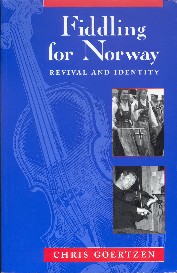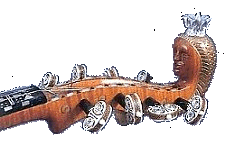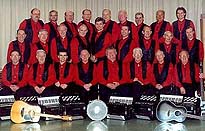|
Fiddling for Norway: Revival and Identity, by Chris Goertzen. University of Chicago Press, 1997. ISBN 0-226-30049-8 (cloth), 0-226-30050-1 (paper), notation, bibliography, index, 16 figures, 17 plates, xv, 347 pp. Cloth $57, paper $22.50 |
|
Goertzen’s field methods include participant-observation of local and national fiddle contests in Norway, starting with a year-long stay, while teaching at the University of Trondheim in 1988-1989. He attended the District Fiddle Contest in 1988, the largest national fiddle contest for the normal fiddle, in Røros. There he was able to hear and record players from around the country play two contrasting tunes each, which gave Goertzen a large collection to consider. He later returned to Norway during the summers of 1991 and 1993 and conducted interviews, made more field recordings, and mined the largest archive of music for the fiddle, Rådet for Folkemusikk og Folkdans (the Council for Folk Music and Folk Dance), at the University of Trondheim for past interviews and field collections. Goertzen points out that the archival holdings privilege the oldest of musicians and repertories, indicating a belief of Norwegian scholars that “the present [is] a window on what is considered to be a richer past” (xiii). His aim is to complement this collection tradition by documenting recent and current fiddling, which he does with exemplary breadth.
|
|
 Fig. 1. "normal" fiddle |
In order to cover new ground for a non-Norwegian audience, Goertzen has focused this study on the “normal fiddle” (referred to as “fiddle”; Figure 1) and de-emphasized the famous Hardanger fiddle (Figures 2a, 2b), which has received more attention both inside and outside Norway, but is not more common among Norwegian folk musicians. |
|
Fig. 2b. Hardanger fiddle pegbox
|
|
Physically the fiddle is indistinguishable from a violin; while the Hardanger fiddle has a decorated body and four sympathetic strings in addition to the four played strings. The Hardanger fiddle’s uniqueness to Norway and its status as a national symbol have caused, especially from an international standpoint, an overshadowing of the fiddle. “[The fiddle’s] tradition is at least as long as that of the Hardanger fiddle,” says Goertzen, “and arguably more vigorous” (xi). While there are players who specialize in one or the other, several of the great fiddlers discussed in the book play both instruments. Goertzen’s isolating the fiddle in this study fills an important niche in the study of folk fiddling in Norway. It is also a reversal of an all too common practice in tradition research: the tendency to simplify categories of expression in service of locating uniqueness in particular national or regional genres. |
|
|
As Goertzen tells us, the modern violin came to Norway in the late 17th century and became extremely popular in rural areas by the early 18th. Norwegian instrumental music was strongly developed in the period starting in the late 18th century and extending to the middle of the 19th. The twentieth century is primarily characterized by revival of this folk music, though not completely lacking in growth as well. The revival phase was marked by the appearance of formal public contests in fiddling, first at the regional level and then eventually growing to include national competitions held in different parts of Norway. The competitive component is intriguing given the popular claim that Norwegians are devoted to egalitarian values. Today it is probably best understood as a method to motivate display of the musicians’ skills and a way to draw in a diverse audience. One wonders if some form of competition has always been a part of folk music, even before the revival phase, and if so what form it took. It seems clear that revival has caused consolidation of tune repertoire and fiddling style, while one may assume that these were more varied when folk fiddling was a regional and community centered art form. The well-known fiddlers indeed traveled around the nation to play at various celebrations (often weddings) and they would learn new tunes and ways of playing from other fiddlers. These traveling musicians provided channels of transmission that were in part based on competition, since the better players would be hired to play and travel more often than less skilled players. Goertzen does a fine job of charting development and characteristics of the revival through location of the contests, types of contests, levels of participation, participants’ occupations and ages, and criteria for judging contestants, and the “home” repertories of individual fiddle clubs, among other elements. But in my view, this would be a richer discussion if we could hear more of what individual players think about the movement and what is important to them. The majority of contextual data is shown through Goertzen’s analytic and synoptic filters and what can fit in a chart or other form of quantification. This sort of documentation is clearly valuable for teaching and comparison with other traditions, but I think it is still very important in an ethnographic document that the source consultants are given a voice. While quotations from contributors to the Norwegian fiddlers journal, Spelemannsblad, somewhat offset this deficiency, we seldom hear Goertzen’s consultants say in their own words what they think about the music they play. A sense of “being there” (Geertz 1988) nonetheless comes through because Goertzen skillfully uses in many sections of the book an evocative and readable narrative style. We know also that during his field research he was simultaneously an insider and outsider, since he played alongside some of the musicians he wrote about. He also experienced while living in Norway in 1988-89 the end stages of what was called the gammaldans (old dance) controversy. The term gammaldans came into use in the early part of the twentieth century to denote Norway’s adaptation of nineteenth century pan-European social dances and accompanying music (e.g. waltzes, mazurkas, reinlenders [slower, duple-time polka variants] and other polka types).
|
|
Fig. 3. Norwegian accordion dance band
|
It is safe to say that all folk musicians discussed in the book have taken part in this tradition as much as they have in the folkemusikk (folk music) revival, but up until ca 1980 the two had been kept apart as separate categories of music. Folkemusikk centers around the solo fiddle and traditional Norwegian fiddle music, a content-oriented genre, while gammaldans typically features accordion music (Figure 3, Audio 3), and is normally the accompaniment to all manner of social dancing, a function-oriented genre. |
|
The technical analysis of mode and form, and the tune anthology that follows, show Goertzen’s great musical erudition. The organization and features are specific to Norwegian fiddling, but this discussion lays down several methodological approaches to transcribing and grouping a body of folk music, that may be profitably exported to studies in other cultures. For instance, he accounts for unusual tunings of the instrument in his transcriptions, which are unique to a tune or fiddler, or typical of a particular community of players. He also grapples with insider and outsider perspectives on relationships between tunes, in order to show boundaries of geography and style, and following Cowdery (1990) locates with modest success tune families. We thus gain access into fiddlers’ methods for grouping tunes in their repertories, and the tunes’ current customary uses, whether for dances, in contests and concerts, or for in-group pleasure. He traces the life of particular tunes as different master fiddlers transform them. The discussion of musical change is fascinating, because we learn about shifts of taste not only among fiddlers, but also among judges and audiences over time. Fiddling for Norway is unquestionably a valuable book with appeal for ethnomusicologists, scholars of Scandinavian and European culture, historians, and lay audiences. As Goertzen says, these fiddlers, their large repertoires, and the holdings in archives comprise a diachronic living museum of enormous size. Chris Goertzen has done the English-reading public a great service by producing such a splendid study of this lively folk institution. |
|
|
Cowdery, James R. 1990. The Melodic Tradition of Ireland. Kent, OH: Kent State University Press. Geertz, Clifford. 1988. Works and Lives: The Anthropologist as Author, pp. 1-24. Stanford: Stanford University Press. Scandinavian Folk Music & Dance Site review | EOL 8 | email author | editor released 11 December 2002 |
|



